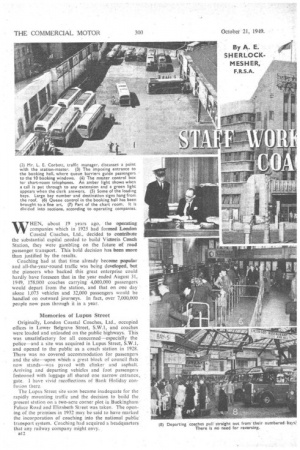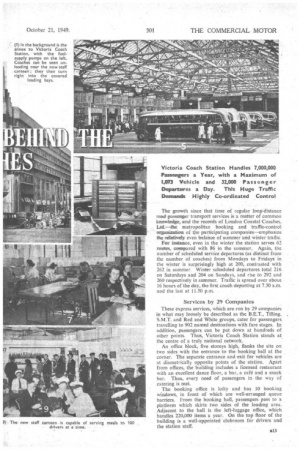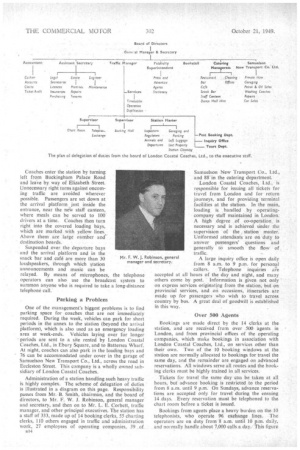THEN, about 19 years ago, the operating companies which in
Page 46

Page 47

Page 48

Page 49

If you've noticed an error in this article please click here to report it so we can fix it.
1925 had formed London Coastal Coaches, Ltd., decided to contribute the substantial capital needed to build Victoria Coach Station, they were gambling on the future of road passenger transport. This bold decision has been more than justified by the results_ Coaching had at that time already become popular and all-the-year-round traffic was being dewiloped, brit the pioneers who backed this great enterprise could hardly have foreseen that in the year ended August 31, 1949, 158,000 coaches carrying 4,000,000 passengers would depart from the station, and that on one day alone 1,073 vehicles and 32000 passengers would be handled on outward journeys. In fact, over 7,000,000 people now pass through it in a year.
Memories of Lupus Street Originally, London Coastal Coaches, Ltd., occupied offices in Lower lielgrave Street, S.W.1, and coaches were loaded and unloaded on the public highways. This was unsatisfactory for all concerned—especially the police—and a site was acquired in Lupus Street, S.W.1, and opened to the public as a coach station in 1928. There was no covered accommodation for passengers and the site--upon which a great block of council flats now stands—was paved with clinker and asphalt. Arriving and departing vehicles and foot passengers festooned with luggage all shared one narrow entrance. gate. I have vivid recollections of Bank Holiday confusion there.
The Lupus Street site soon became inadequate for the rapidly mounting traffic and the decision to build the present station on .a two-acre corner plot in 13uckingharn Palace Road and •Eliabeth Street was taken. The opening of the premises in 1932 may be said to have marked the incorporation of coaching into the national public transport system. Coaching had acquired a headquarters that any railway company might envy..
n12
Tlirtz growth since that time of regular long-distance mad passenmer transport services is a matter of common knowiledige,and the records of London Coastal Coaches, Lit—date metropolitan booking and traffic-control orga,mizaftion of the participating companies—emphasize
aaarEivetbr even balance of summer and winter traffic.
FlaT instance, even in the winter the station serves 62 motes, -oompared with 86 in the summer. Again, the number of scheduled service departures (as distinct from the number of coaches) from Mondays to Fridays in the winter is surprisingly high at 200, contrasted with 262 in summer. Winter scheduled departures total 216 on Saturdays and 204 on Sundays, and rise to 292 and 260 respectively in summer. Traffic is spread over about
16 hours of day, the first 'coach ,departing at 7.30 a.m. and the last at 11.50 p.m.
Services by 2'9 Companies
These express services, which are run by 29 companies in what may loosely be described as the B.E.T., Tilling, S.M.T. and Red and White groups, cater for passengers travelling to 902 named destinations with fare stages. In addition, passengers can be put down at hundreds of other points. Thus, Victoria Coach Station 'stands at the centre of a truly national network.
• An office block, five storeys high, flanks the site on two sides with the entrance to the booking hall at the corner. The separate entrance and exit for vehicles are at diarnetriCally opposite points of the station. Apart from offices, the building includes a licensed restaurant with an excellent dance floor, a bar, a cafe and a snack bar. Thus, every need of passengers in the way of catering is met.
The booking office is lofty and has 10 booking windows, in front of which are well-arranged queue barriers. From the booking hall, passengers pass to a platform which skirts two sides of the loading area Adjacent to the hall is the left-luggage office, which handles 220,000 items a year. On the top floor of the building is a well-appointed clubroom for drivers and the station staff.
Coaches enter the station by turning left from Buckingham Palace Road and leave by way of Elizabeth Street. Unnecessary right turns against oncoming traffic are avoided wherever possible. Passengers are set down at the arrival platform just inside the entrance, near the new staff canteen, where meals can be served to 100 drivers at a time. Coaches then turn right into the covered loading bays, which are marked with yellow lines. Above them are large number and* destination boards.
Suspended over the departure bays and the arrival platform and in the snack bar and café are more than 30 loudspeakers, through which station announcements and music can be relayed. By means of microphones, the telephone operators can also use the broadcast system to summon anyone who is required to take a long-distance telephone call.
Parking a Problem One of the management's biggest problems is to find parking space for coaches that are not immediately required. During the week, vehicles can park for short periods in the annex to the station (beyond the arrival platform), which is also used as an emergency loading area at week-ends. Vehicles laying over for longer • periods are sent to a site rented by London Coastal Coaches, Ltd., in Ebtiry Square, and to Battersea Wharf. At night, coaches can also park in the loading bays and 76 can be accommodated under cover in the garage of Samuelson New Transport Co., Ltd., across the road in Eccleston Street. This company is a wholly owned subsidiary of London Coastal Coaches.
Administration of a station handling such heavy traffic is highly complex. The scheme of delegation of duties is illustrated in a diagram on this page. Responsibility passes from Mr. B. Smith, 'Chairman, and the board of directors, to Mr. F. W. J. Robinson, general manager and secretary, and then on to Mr. L. E. Corbett, traffic manager, and other principal executives. The station has a staff of 333, made up of 14 booking clerks, 55 charting clerks, 110 others engaged in traffic and administration work, 27 employees of operating companies, 39 .of
Samuelson New Transport Co., Ltd., and 88-in the catering department.
• London Coastal Coaches, Ltd., is responsible for issuing all tickets for travel from London and for return journeys, and for providing terminal facilities at the station. In the main, loading is handled by operatingcompany staff maintained in London. A high degree of co-operation is necessary and is achieved tinder the supervision of the station master. Uniformed attendants are on duty to answer passengers' questions and generally to smooth the flow of traffic.
A large inquiry office is open daily from 8 a.m. to 9 p.m. for personal callers. Telephone inquiries are accepted at all hours of the day and night, and many others come by post. Information is given not only on express services originating from the station, but on provincial services, and on occasions, itineraries are made up for passengers who wish to travel across country by bus. A great deal of goodwill is established in this way.
Over 500 Agents
Bookings are made direct by the 14 clerks at the station, and are received from over 500 agents in London, and from provincial offices of the operating companies, which make bookings in association with London Coastal Coaches, Ltd., on services other than their own. Two of the 10 booking windows at the station are normally allocated to bookings for travel the same day, and the remainder are engaged on advanced reservations. All windows serve all routes and the booking clerks must be highly trained in all services.
Tickets for travel the same day can be taken at all hours, but advance booking is restricted to the period from 8 a.m. until 9 p.m. On Sundays, advance reservations are accepted only for travel during the ensuing 14 days. Every reservation must be telephoned to the chart room before a ticket is issued.
Bookings from agents place a heavy burden on the 10 telephonists, who operate 96 exchange lines. The operators are on duty from 8 a.m. until 10 p.m. daily, and normally handle about 7,000 calls a day. This figure rises to 10,000 at peak periods. After 10 p.m. a male night staff takes aver.
There is also a large business in postal bookings and as many as 500 applications for tickets have been received by post in a day. With the extension of book• ings over periods of up to six months ahead of the date of travel, the heed for the utmost accuracy in charting has become acute.
Each coach has a separate chart on which reservations coming from the station, from agents and by post are entered. The source of booking, picking-up point, type of ticket (single, day return, or period return), ticket number, number of passengers, destination and details of the return journey (if required) are shown. On many services, it is necessary to record full details of the return journey at the time of booking. Reservations by passengers returning from London have also to be noted. Without rigid control of charting, many services, particularly at week-ends, would soon become overbooked.
The tralEc clerks work in two main shifts from 8 a.m. until 10 p.m., after which a night staff takes over. Night work is confined mainly to postal applications for tickets and return reservations by companies.
The chart roam is divided into company sections, which, wherever possible, are grouped geographically. In training new staff, the principle followed is to transfer clerks from section to section during the first year, so that varied experience is gained.
In a corner of the chart room is a master telephone control box, on which an amber light shows when a call is put through to each extension. • A green light appears When the clerk answers the call. The chart-room supervisor can thus see at a glance whether any section is overloaded and can arrange relief.
Tickets issued by agents are in four parts, of which the passenger receives two, The third copy is for confirmation of the booking and is sent in daily by agents. The fourth copy is for audit purposes, and is sent to the station at the end of each week. Agents' tickets can be used for single, day return and period return bookings. Tickets issued by the station are in three parts, the confirmation copy being unnecessary.
An audit department checks daily sales of tickets by the coach station with the ticket audit copies, and the agent's weekly invoices with the audit copies sent in. The Powers-Samas system of punched cards is employed to record every ticket sold. Cards are sorted according to operating companies and monthly schedules of all tickets sold on each operating company's behalf are prepared. This work is normally completed within 10 days after the end of each month. The sorting machine can handle 400 cards a minute.
Agents are selected by an appointments committee on the basis of a report made by a senior official after a visit to the applicant. The object is to ensure that there is at least one reliable agent in every district of London. Supervision of agents and agency inspectors is one of the • many duties, of the publicity department. About once every three weeks, each agency is visited by the department's Cornmer van, which brings timetables, posters, tickets and other materials.
The London Coastal company's interests are.not con tined solely to express services. There is rapidly growing activity in bookings for tours in the United Kingdom and on the Continent, which are handled by a separate department. In this way, the organization is taking its part in the vital business of earning •dollars from American visitors.
Just as an army cannot function effectively without that complex and often-maligned machine known as the general staff, so the coaches that have become the accepted means for travel for millions of people in this country must be backed by a carefully planned control organization. London Coastal Coaches, Ltd., provides that service for many of the vehicles that leave London daily throughout the year for all parts of the Kingdom, and the company can justly take some of the credit for the outstanding success of the road passenger transport industry.




























































































